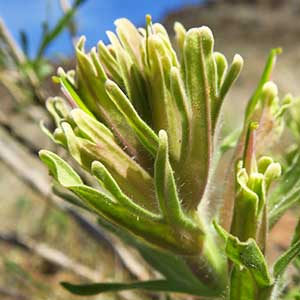Castilleja xanthotricha
Castilleja christii
John Day or yellow-hairy paintbrush, John Day paintbrush, yellow hair paintbrush, yellow-hair Indian paintbrush
Christ's Indian paintbrush, John Christ's paintbrush
few to several, ± decumbent to erect or ascending, unbranched, sometimes with short, leafy axillary shoots, hairs erect to spreading, long, soft, eglandular, mixed with short stipitate-glandular ones.
several, erect to ascending, unbranched, sometimes branched, glabrous or hairs spreading, short and long, ± stiff, sometimes stipitate-glandular especially distally.
green, linear, lanceolate to broadly lanceolate, oblong, or cuneate, 0.8–5 cm, not fleshy, margins plane to wavy, involute, 0–5-lobed, apex acute, sometimes rounded;
lobes spreading, linear, arising below mid length, nearly as broad as center lobe, apex acute.
green, narrowly to broadly lanceolate, (1–)2–5(–6) cm, not fleshy, margins plane, flat or involute, (0–)3(–5)-lobed, apex acute to rounded;
lobes erect or ascending, linear, lanceolate, or triangular, sometimes very small, apex acute to rounded.
3–14 × 1.5–4.5 cm;
bracts proximally greenish, rarely dull reddish purple, distally white to cream, rarely pale yellow or dull, pale pink (sharply differentiated from proximal coloration), lanceolate or oblong to narrowly ovate, (3–)5–7-lobed;
lobes ascending, linear to obovate, ± broadened distally, medium, long, proximal lobes arising below mid length, central lobe apex broadly rounded to truncate, others acute to rounded.
3–6 × 2–4 cm;
bracts proximally greenish, distally pale orange or pale yellow, sometimes red-orange, lanceolate or narrowly elliptic to ovate, sometimes obovate, 3–5-lobed;
lobes ascending, linear, medium length to long, arising at or below mid length, apex acute to obtuse.
curved, 17–23 mm;
tube 15–19 mm;
beak exserted, adaxially green, 5–8(–9) mm, puberulent, stipitate-glandular;
abaxial lip deep purple (color sometimes visible through calyx), green, pinkish, or pale yellow, ± prominent, slightly inflated, usually hidden in calyx, sometimes right at top of calyx, 2 mm, ca. 50% as long as beak;
teeth ascending, whitish, yellowish, pink, or green, 1–1.5 mm.
straight, 20–30 mm;
tube 12–19 mm;
beak exserted, adaxially green, 7–12 mm;
abaxial lip green, reduced, included or visible through cleft, 1.5–2 mm, 10–20% as long as beak;
teeth incurved, deep green, 1.5 mm.
colored as bracts, 15–26 mm;
abaxial and adaxial clefts 3.5–7 mm, 25–50% of calyx length, deeper than laterals, lateral 2–5 mm, 12–25% of calyx length;
lobes linear, oblong, or narrowly triangular, center lobe apex usually rounded, lobes acute to rounded.
colored as bracts, 17–22(–24) mm;
abaxial clefts 9–12(–13) mm, adaxial 7–11 mm, clefts 50% of calyx length, deeper than laterals, lateral 2–6.5(–8.5) mm, 20–50% of calyx length;
lobes lanceolate to narrowly lanceolate, apex acute to obtuse.
= 48.
Castilleja xanthotricha
Castilleja christii
Castilleja xanthotricha is endemic to moderate elevations in the sagebrush hills of the John Day River drainage in north-central Oregon. N. H. Holmgren (1971) hypothesized that this tetraploid species is of allopolyploid hybrid origin between C. glandulifera and C. oresbia.
(Discussion copyrighted by Flora of North America; reprinted with permission.)
Castilleja christii is endemic to subalpine meadows near the summit of Mt. Harrison in the Albion Mountains, Cassia County. Morphologically, it most closely resembles the widespread C. hispida var. acuta, but a recent molecular study (D. L. Clay et al. 2012) presents clear evidence for a homoploid hybrid origin for the species, incorporating portions of the genomes of C. linariifolia and C. miniata. This is the first documented case of homoploid origin in Castilleja.
Castilleja christii is in the Center for Plant Conservation’s National Collection of Endangered Plants.
(Discussion copyrighted by Flora of North America; reprinted with permission.)
